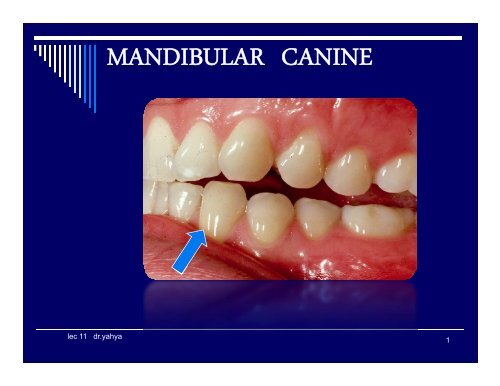You also want an ePaper? Increase the reach of your titles
YUMPU automatically turns print PDFs into web optimized ePapers that Google loves.
CHRONOLOGY Initial calcification : 4 – 5 month after birth Completion of crown:6 – 7 years Eruption : 9 – 10 years Completion of root : 12 – 14 yearslec 11 dr.yahya2
+0.4 mm.-0.8 mm.Its features are less well developedthan those of upper canine.Its crown appears long and narrow comparedwith that of upper canine.It is actually 0.4 mm. longer and 0.8 mm.narrower.lec 11 dr.yahya4
Labial aspectThe crownThe mesial outline:‣Is nearly straight from the cervicalline to the mesial contact area, thencontinues to the cusp slope.‣It is nearly in line with the mesialside of the root and does not projector bulge beyond the root outline.Mlec 11 dr.yahya5
Labial aspectThe crownThe distal outline:Is slightly concave in the cervical third, then,it becomes convex incisally.It projects beyond the root outline. The distaloutline is shorter than the mesial outline.From this aspect the crown appears to betilted or bent distally due to the difference inmesial and distal outlines.Dlec 11 dr.yahya6
Labial aspectThe crownIncisal outline:The cusp tip is usually on the rootaxis line.Its slopes form a more obtuse anglethan those of upper canine.The cusp is less pointed than that ofupper canine.lec 11 dr.yahya7
Incisal aspect : (Cont.) The mesial slope of the cusp isshorter than the distal slope, more sothan on maxillary canine. The mesial cusp slope is also in amore nearly horizontal plane comparedto the longer distal cusp slope, whichslopes more severely in an apicaldirection.lec 11 dr.yahya8
Labial aspectContact areasMesial In the incisal third just below themesioincisal angle.Distal At the junction of the middle andincisal thirds, more cervically locatedthan the mesial contact area.lec 11 dr.yahya9
Labial aspectCervical lineIt has a semicircularcurvature root ward.lec 11 dr.yahya10
lec 11 dr.yahya 11
Morphology of the labial surfaceThe labial surface is smooth and convex.It often shows a labial ridge, which is not asprominent as on the upper canine.Shallow vertical depressions may be presenton either side of the labial ridge in the incisalthird.The incisal third of the crown is slightlyflattened mesial and distal to the labial ridge.lec 11 dr.yahya12
The root-0.6 mm -2 mm. The root is shorter than that of the uppercanine by 0.6 mm to 2 mm. Its apical end is more sharply pointed. Its apical end is more often straight thancurving toward mesial or distal sides. The root is convex on the labial surface.lec 11 dr.yahya13
Lingual aspectThe crownThe crown taper toward the lingual surface. The lingual surface of the crownresembles those of the lower incisorsin being smooth. However: A faint lingual ridge is running fromthe cusp tip to the cingulum.lec 11 dr.yahya14
Lingual aspectThe crownThe cingulumis poorlydeveloped The marginal ridges are not prominent. The mesial marginal ridge is longer and straighterthan the shorter, more elevated and curved distalmarginal ridge.lec 11 dr.yahya15
The Root The lingual portion of the root is narrowerthan that t of the upper canine. The lingual surface of the root is convex.lec 11 dr.yahya16
Mesial aspectThe Crown The mesial surface of the crown iswedge-shaped. The crown mesially is longer than that ofupper canine. The crown is narrower labiolinguallythan the upper canine (by 0.4 mm).lec 11 dr.yahya17
Mesial aspect The labial outline has less curvaturethan that of upper canine with verylittle crest of curvature directly abovethe cervical line.The lingual outline is similar to that of the uppercanine, but differs in degree. The cingulum is notprominent. Incisally: the incisal portion of the crown is thinnerlabiolingually.li lllec 11 dr.yahya18
Mesial aspect The cusp appears more pointed. The tip of the cusp is most oftenlocated slightly lingual to the rootaxis line, but it may be centeredover it.lec 11 dr.yahya19
Cervical lineCurves more incisally than doesthe cervical line on upper canine.lec 11 dr.yahya20
lec 11 dr.yahya 21
The Root The root surface is similar to thatof the upper canine from the mesialaspect except: The root tip is more pointed thanthat of upper canine. The developmental depressionmesially is more pronounced thanthat on upper canine.lec 11 dr.yahya22
Distal aspect The general shape from the distalaspect is similar to the shape from themesial aspect. The distoincisal angle is slightly morelingual in position than the cusp tipbecause of the distolingual twist of thecrown (similar to lower lateral incisors). The cervical line curvature is less on thedistal surface than on the mesial surface.lec 11 dr.yahya23
The RootThe vertical developmentaldepression on the distal sideof the root is often deeperthan the depression on themesial side.D.AM.A.lec 11 dr.yahya24
Incisal aspect The outline of lower canine from the incisalaspect is often similar to that of upper canine. The labiolingual li l dimension i of the crown islonger than the mesiodistal dimension similar toupper canine.lec 11 dr.yahya25
Incisal aspectDMThe cusp tip is more likely to be inclined lingually.Labially, the mesiolabial outline is more convexwhile the distolabial outline is flat or concaveThe distal cusp slope is directed d slightly lingually llfrom the cusp tip, which places the distoincisalangle in a lingual position to the cusp tip.lec 11 dr.yahyaMD26
-This lingual placement of the distoincisalangle gives the incisal part of the crown adistolingual twist like lower lateral incisor.This twist t matches closely l the curvatureof the dental arch.The crown tapers lingually and the cingulumis represented by a curved line.lec 11 dr.yahya27
lec 11 dr.yahya28


